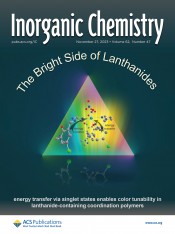resumo
This work reports the structural characterization and photophysical properties of Dy-III, Tb-III, and Eu-III coordination polymers with two phenoxo-triazole-based ligands [2,6-di(1H-1,2,4-triazole-1-yl-methyl)-4-R-phenoxo, L (R) Tr (R = CH3; Cl)]. These ligands permitted us to obtain isostructural polymers, described as a 1D double chain, with Ln(III) being nona-coordinated. The energies of the ligand triplet (T-1) states were estimated using low-temperature time-resolved emission spectra of Y-III analogues. Compounds with (LTr)-Tr-Cl present higher emission intensity than those with (LTr)-Tr-Me. The emission of Tb-III compounds was not affected by the different excitation wavelengths used and was emitted in the pure green region. In contrast, (DyLTr)-Tr-Me emits in the blue-to-white region, while the luminescence of (DyLTr)-Tr-Cl remains in the white region for all excitation wavelengths. On the other hand, Eu-III compounds emit in the blue (ligand) or red region (Eu-III) depending on the substituent of the phenoxo moiety and excitation wavelength. Theoretical calculations were employed to determine the excited states of the ligands by using time-dependent density functional theory. These calculations aided in modeling the intramolecular energy transfer and rationalizing the optical properties and demonstrated that the sensitization of the Ln(III) ions is driven via S-1 -> Ln(III), a process that is less common as compared to T-1 -> Ln(III).
palavras-chave
INTRAMOLECULAR ENERGY-TRANSFER; METAL-ORGANIC FRAMEWORKS; AB-INITIO PSEUDOPOTENTIALS; WHITE-LIGHT EMISSION; LANTHANIDE AQUO IONS; CHARGE-TRANSFER; PHOTOPHYSICAL PROPERTIES; EFFICIENT SENSITIZATION; ABSORPTION INTENSITIES; EUROPIUM COMPLEX
categoria
Chemistry
autores
Manzur, J; Fuentealba, P; Gil, Y; Pérez-Obando, J; Alfaro, JM; Carvallo, AIV; Aravena, D; de Santana, RC; Neto, ANC; Spodine, E
nossos autores
Projectos
CICECO - Aveiro Institute of Materials (UIDB/50011/2020)
CICECO - Aveiro Institute of Materials (UIDP/50011/2020)
Associated Laboratory CICECO-Aveiro Institute of Materials (LA/P/0006/2020)
Other
Capa
Mediaagradecimentos
E.S., J.M., P.F., J.M.A., and A.V. acknowledge financial support from FONDECYT 1200033 grant. This study was financed in part by the Brazilian agencies, Conselho Nacional de Desenvolvimento Cientiifico e Tecnologico (CNPq, 427164/2018-4), and Fundacao de Amparo a Pesquisa do Estado de Goias (FAPEG). RCS thanks the CNPq research fellowship 310,307/2021-0. Powered@NLHPC: this research was partially supported by the supercomputing infrastructure of the NLHPC (ECM-02). This work was developed within the scope of the projects CICECO-Aveiro Institute of Materials, UIDB/50011/2020, UIDP/50011/2020, and LA/P/0006/2020, The Shape of Water (PTDC/NAN-PRO/3881/2020), and LogicALL (PTDC/CTM-CTM/0340/2021), financed by national funds through the FCT/MCTES (PIDDAC).



